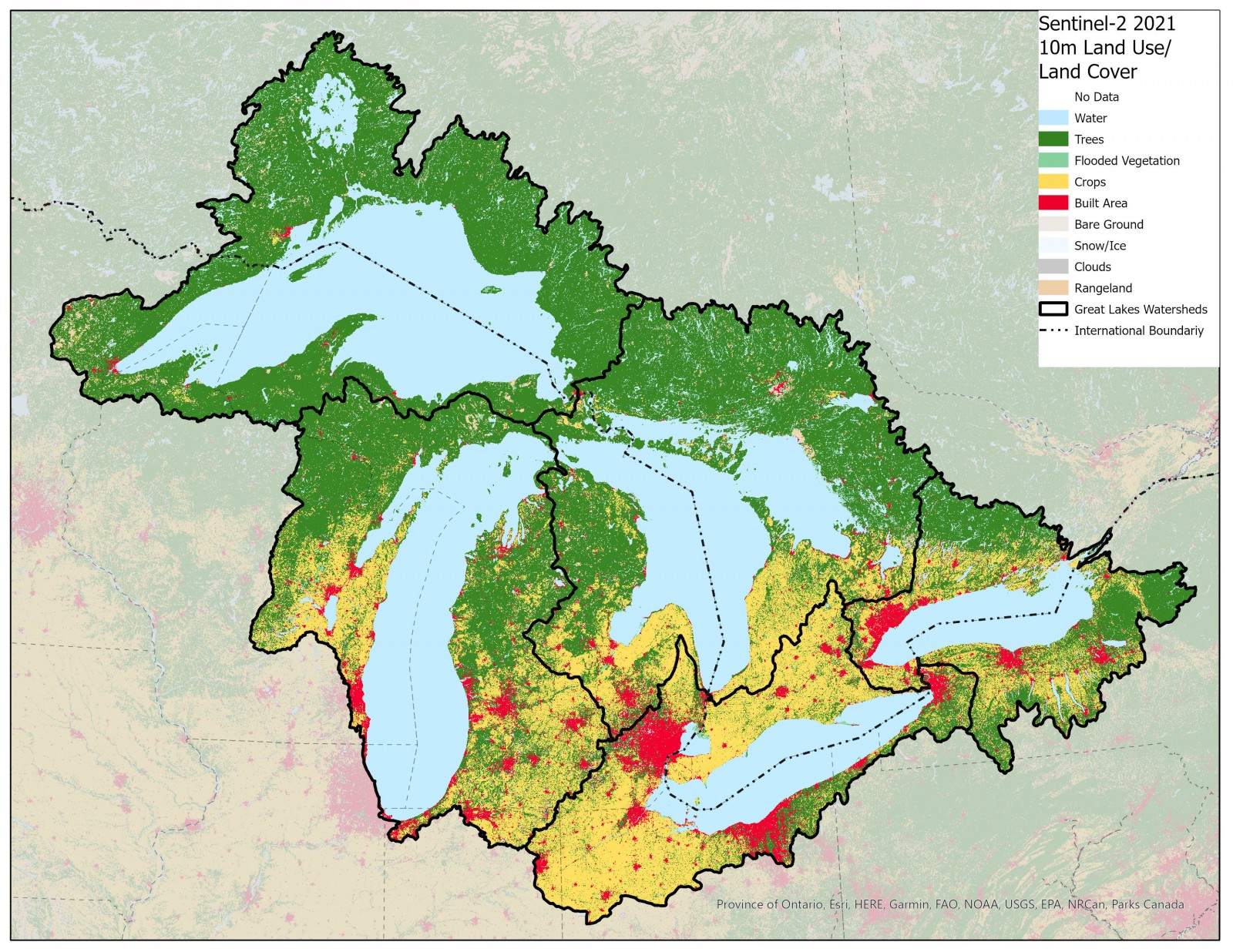Forest to MI Faucet: Using Trees to Keep Water Sources Pristine
By Lester Graham, Michigan Radio – April 24, 2023
A forest expert at the Michigan Department of Natural Resources is putting together a program to use trees to help keep sources of drinking water cleaner.
Forests slow water down. When intense rains hit, trees can help reduce rapid runoff which can wash dirt into streams and lakes. The shade from trees cools the water which is becoming more critical as climate change is warming lakes and streams. Forests floors also filter water, helping to keep it clean.
Mike Smalligan is the Forest Stewardship Coordinator for the Department of Natural Resources.
As part of a slide show at DNR Headquarters, he shows me a map that outlines how much of the watershed for each Great Lake is forest, agriculture, and urban. Thanks in no small part to Canada, the watersheds of Superior and Huron are mostly forested. It’s less so for Lakes Michigan and Ontario. Lake Erie’s watershed is mostly agricultural and urban areas.
- Lake Superior 91% forest cover in watershed
- Lake Huron 67% forest cover in watershed
- Lake Michigan 49% forest cover in watershed
- Lake Ontario + 50% forest cover in watershed
- Lake Erie 19% forest cover in watershed
“So just looking at the land use of these watersheds, it becomes pretty clear and intuitive to people that as we replace forests with factories and farms and urban sprawl, that’s where we’re getting, you know, impacts on our water quality,” Smalligan said.
Refresh
A Great Lakes News Collaborative series investigating the region’s water pollution challenges.
This series explores the Clean Water Act’s shortcomings in the Great Lakes, and how the region can more completely address water pollution in the next 50 years.
The collaborative’s four newsrooms — Bridge Michigan, Circle of Blue, Great Lakes Now, and Michigan Radio — work collaboratively to report on the most pressing water issues in the Great Lakes region. The collaboration is funded by the Charles Stewart Mott Foundation.

Credit: Province Of Ontario, Esri, HERE, Garmin, FAO, NOAA, USGS, EPA,NRCan, Parks Canada
Learn more about the condition of the Great Lakes here.
So, the DNR has created a program named Forest to MI Faucet. It builds on a federal program that educates landowners and others about the connections between forests and water. The Michigan idea is to plant trees in the places where they can make a difference in the quality of the water that we end up drinking.
The Department of Natural Resources is using money from the USDA Forest Service and the National Fish and Wildlife Foundation. That will support 12 conservation groups in different regions in the state with each getting $50,000 for a three year project.
Those conservation groups will have to team up with the folks who are responsible for our drinking water.
“The main thing that we’re doing is reaching out to municipal water utilities and asking them, how can we help you implement your source water protection plan? How can we help you reduce your treatment costs by taking good care of the land in the upstream part of the watershed,” Smalligan explained.
A few days later, on a trail near Traverse City. D.J. Shook wanted to show me a project his group, the Conservation Resource Alliance (CRA), did. From an overlook, we saw where the Boardman River was once dammed up and the valley below was a lake. This part of the Boardman is now a free and flowing river again. And dotted along the course of the river through the valley are young trees planted by the CRA.
“We had this great opportunity to restore riparian forests buffer right along the edge of the river, which has a lot of benefits, one of them being water quality protection and improvement,” Shook said.
The Boardman River empties into the Grand Traverse Bay. Traverse City gets its drinking water from the bay.
And keeping water clean before the water treatment plant takes it in, can mean less cost to purify it for drinking water. D.J. Shook says that’s where the idea of Forest to MI Faucet makes a lot of sense.
“By far increasing the forested area that drains into a body of water is the cheapest way to protect it for the long term and keep the clean water clean.”
So, the Conservation Resource Alliance is talking with the City, asking what the Alliance can do to help keep the water that flows to the bay cleaner.
Frank Dituri is the Traverse City Director of Public Services. He hiked with us out to this site overlooking the Boardman River.
“Anyone with an ecological conscience realizes that that the quality of the water on the land that winds up in our streams and lakes is is something we all need to have care with,” Dituri said.
He pointed out the Eastern sandhill cranes and deer below.
Dituri says there are many sources of water that enter the Grand Traverse Bay. The fast growing area is becoming more urban. Upstream of some of the rivers that empty into the bay many of the homes and lake communities are using septic tank systems. The Department of Environment, Great Lakes, and Energy says about one-fourth of septic systems in the state are failing.
Thinking about water quality and using nature to help filter it before it enters the bay is kind of a no-brainer.
“If you really think about it, well, it’s long overdue. I think as we start to grow our mindset and we understand how connected everything is, how could we not be having this kind of conversation regarding our water resources,” Dituri pondered.
The head of Conservation Resource Alliance, Amy Beyer, has spent decades planting trees along streams to help create wildlife corridors. Those tree-lined rivers and creeks connect green spaces across the northern part of the lower peninsula of Michigan. The corridors allow wildlife such as bears, owls, and mink to connect with mates and find food in the streams. She says this kind of partnership that the D-N-R is backing offers even more benefits.
“It saves the city money, it improves people’s drinking water quality, and it improves the entire fish and wildlife ecosystem of the watershed to do one thing, and that is plant trees,” she said.
The Forest to MI Faucet program is encouraging foresters and municipal water treatment operators across the state to get together to review source water assessment plans. If they can pinpoint areas where planting trees could protect a stream or lake, it could make a real difference in the quality of the water that ultimately comes out your faucet.
Featured Image: A moose at Isle Royale. Vast forests keep Lake Superior’s water quality high. But other Great Lakes are on the tipping point because of agriculture and urban sprawl. Photo by Lester Graham, Michigan Radio
Related
© 2023 Circle of Blue – all rights reserved
Terms of Service | Privacy Policy



